Small Shrubs For Shade (With Pictures) – Identification Guide
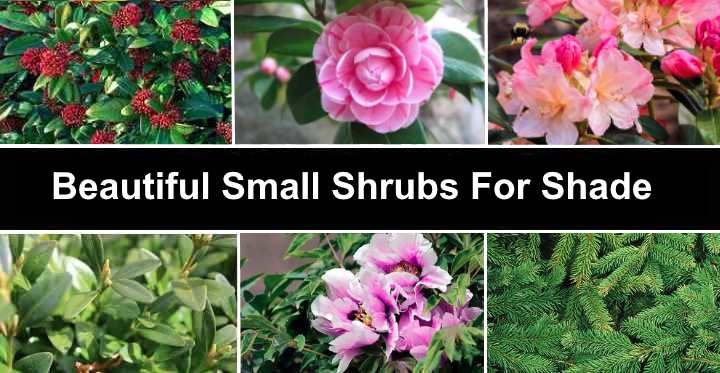
Small shrubs for shade gardens are an excellent option to add lush greenery, vibrancy, and a pop of color to your yard. Small shade-tolerant shrubs are ideal for your front or backyard because they require little care and almost no pruning. In addition, small shrubs are incredibly versatile because they are perfect for growing in shaded mixed borders, along a foundation line, as a low-growing hedge or privacy screen.
Landscape shrubs with a natural short stature can be deciduous or evergreen ornamental bushy plants. Flowering evergreen shrubs for shade provide year-long color, even in cold winters. Other small deciduous perennial shrubs have colorful blossoms that fill spring and summer landscapes with sweet fragrances.
Choosing the ideal small shrubs for a shady garden landscape can be difficult. Some small shrubs perform well in minimal sunlight, whereas others grow better in partial shade. Other varieties of dwarf shade shrubs will tolerate morning and late afternoon sun but need protection during the day.
This article will help you identify the best small shrubs that perform well in partial shade, dappled shade, or complete shade. Pictures of small shade-tolerant shrubs and descriptions of their leaves and flowers will help you choose the best bushy plants for your shaded garden.
How to Choose Small Shrubs for Shade
Several factors will affect your choice when deciding on small shrubs to plant in your front or backyard. These are the USDA growing zone, sun exposure levels, soil type, and maintenance requirements. Additionally, look for shrubs that are drought-tolerant, pest and disease-free, and require little pruning to maintain their height.
Sun Exposure: Full Shade, Dappled Shade and Partial Shade
Small shade shrubs have various requirements for levels of direct sunlight they can tolerate. For success when growing small shrubs in the shade, pay attention to whether they need partial sun, partial shade, dappled shade, or complete shade. What is the difference between these levels of shade?
Here is a quick guide to help choose suitable small decorative shrubs that grow in various levels of shade:
- Full sun—Shrubs can tolerate at least six hours of direct sunlight daily. These outdoor plants can thrive in open garden landscapes with no tall trees or structures nearby.
- Light shade—Small shrubs require between four and six hours of direct sunshine daily.
- Partial shade—Sun exposure for these small shrubs is also around four to six hours. However, shrubs for partial shade require shade during the middle of the day. Therefore, only direct sun in the morning and late afternoon or evening is allowable.
- Dappled shade—Think of sunlight filtering through a tree canopy or pergola. This is a mixture of sun and shade. Shrubs for dappled shade also do well in full shade.
- Full shade—Shrubs for complete shade are happy getting no direct sunlight in the day. These small shrubs thrive in the understory or growing in constant shadows.
Identifying the Best Small Shrubs for Shade
Your landscape requirements can help identify the best small and dwarf shrubs for shaded areas. For example, shade-loving dwarf camellia, azalea, and bushy peony plants fill summer landscapes with color and floral scents. Or small evergreen shrubs like boxwood, pittosporum, and holly are perfect for privacy screens or hedges in most shade levels.
Types of Small Shrubs for Shade (With Pictures) – Identification Guide
Do you want to find the best shade-adapted, small evergreen bushy plants for your landscape? Or do you need to find flowering, low-growing shrubs that don’t require hours of direct sunlight? If so, please read on to find varieties of small shade shrubs.
Small Camellia Shrubs (Camellia sasanqua, Camellia japonica)

Low maintenance evergreen dwarf camellia shrubs are suitable for landscaping shaded gardens
Small camellia shrubs are identified as flowering evergreen landscaping plants with spectacular showy flowers. Camellia blooms are typically semi-double or double flowers in pink, white and red shades. Masses of large blossoms cover the attractive shrub from late winter until early spring. Dwarf camellia shrubs grow 3 to 6 ft. (1 – 1.8 m) tall.
The two most popular varieties of ornamental camellia shrubs are Japanese camellias (Camellia japonica) and Camellia sasanqua. Generally, Camellia sasanqua is the hardiest variety, and small Japanese camellia shrubs have the showiest flowers. Flowers can be cup-shaped, rosette, or have frilled petals.
Small camellia shrubs are ideal for brightening up shaded landscapes. The attractive shrubs thrive as foundation plantings, specimen shrubs, or mixed borders. You can also grow them in pots to liven up a shady patio or decking area. Camellias are also on the list of shade shrubs suitable for growing in Florida.
USDA growing zones: 7 to 9
Soil: Well-draining acidic soil with plenty of organic matter
Sun exposure: Full sun, light shade, or full shade (check individual cultivars)
Evergreen Compact Japanese Holly (Ilex crenata ‘Compacta’)
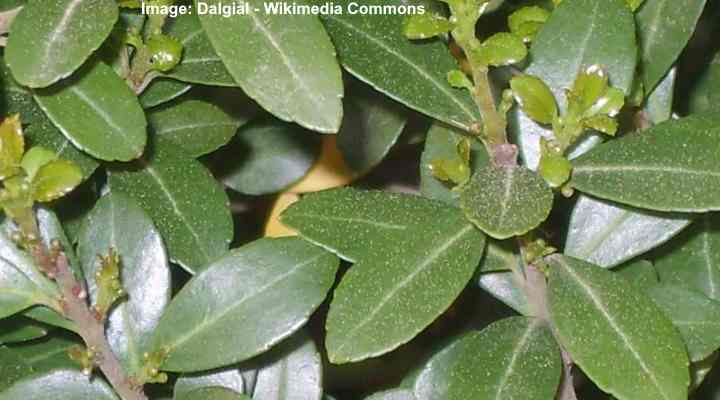
Evergreen compact Japanese holly can grow in partial shade and has an attractive rounded shape
Japanese holly is a relatively small shrub with clusters of fragrant greenish-white flowers, thick leathery leaves, and small black berry-like drupes. The ornamental evergreen low-growing shrub has a rounded growth habit. The holly ‘Compacta’ cultivar is smaller than other decorative holly shrubs. It grows up to 6 ft. (1.8 m) tall and wide.
Japanese holly shrub is shade tolerant and will perform well in full sun. The lush, globose, multi-branched shrub is an excellent choice to grow as an evergreen privacy hedge, foundation planting, mixed shrub border, or specimen plant.
USDA growing zones: 6 to 8
Soil: Medium moisture, well-draining soils; it’s also drought tolerant
Sun exposure: Full sun to partial shade
Dwarf Virginia Sweetspire Shrub (Itea virginica)
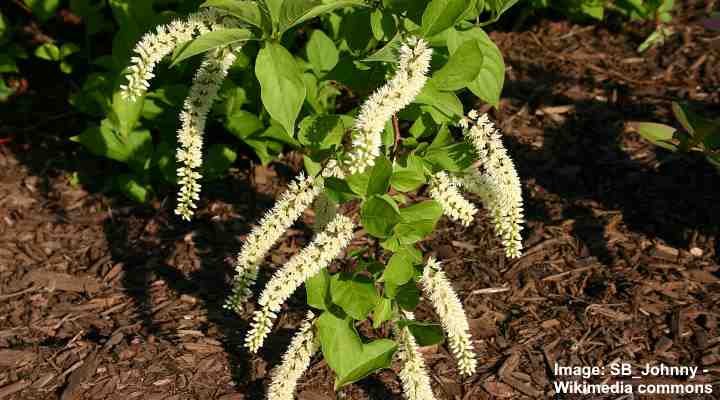
The low growing shade loving sweetspire shrub is great for landscaping compact spaces
Virginia sweetspire is an eye-catching small flowering shrub for full shade. Identifying features of the deciduous shrub are its arching, white bottlebrush flowers and lush green foliage. When the white-flowering shrub is in bloom during spring and summer, masses of white spikes flowers cover the plant.
Reasons to plant Virginia sweetspire in a garden landscape include its long-blooming time, attractive orange and red shades in the fall, and that it attracts pollinators.
Small varieties of Virginia sweetspire shrubs grow 3 ft. (1 m) tall. This makes the flowering shade shrub ideal as a foundation plant, informal hedge, ground cover for shade, or a shrub border. The perennial shrub is also suitable for most climates.
USDA growing zones: 5 to 10
Soil: Most well-draining soil types, including medium to wet.
Sun exposure: Full sun to complete shade; note that the best flowering occurs in full sun or light shade
Small Evergreen and Deciduous Azalea Shrubs (Rhododendron spp.)

Flowering azalea shrubs include small cultivars that will give stunning color to partially shaded garden
Small azalea shrubs are identified by their showy trumpet-shaped flowers, glossy green leaves, and attractive rounded shape. Shade-tolerant, dwarf azalea shrubs make perfect landscaping bushy plants with their showy floral displays in shades of orange, pink, red, yellow, and white blossoms. Dwarf azaleas grow 1 to 4 ft. (0.3 – 1.2 m) tall.
Small azalea shrubs for shade gardens typically prefer moist soil and partial shade. The ornamental azalea shrubs are ideal for creating flowering hedges, appealing foundation plantings, driveway borders, or flowering specimen plants.
The spring-blooming shrubs have various flower forms and colors to suit every landscape. You can choose shrubs with orange, pink, or yellow funnel-shaped flowers. There are also dwarf azaleas with cup-shaped or star-shaped flowers in lilac, deep pink, pale yellow, or white shades.
USDA growing zones: 4 to 9, depending on the cultivar
Soil: Constantly moist, well-drained soil
Sun exposure: Full sun to light shade
Boxwood (Buxus)
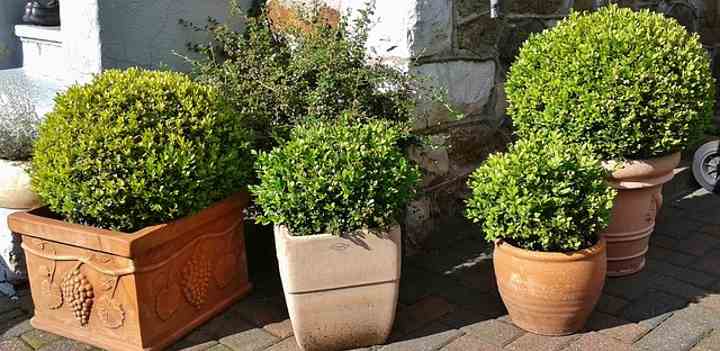
Place small evergreen boxwood shrubs in the front of house to increase the curb appeal or as a decorative element in sunny or shaded areas
Boxwood is a group of evergreen plants, many of which are shade tolerant low-growing evergreen shrubs. Small boxwood shrubs adapt well to all light exposure levels—from full shade to full sun. Small shrub cultivars are identified by their dark green, glossy rounded leaves that stay green all year long.
The small landscape shrubs for shade typically have a rounded habit. They are easy to trim for topiary, formal hedgerows, lining garden beds, and foundation plantings. In addition, because the small shrubs are compact and easy to care for, the shade-loving plants perform well in containers on patios and in shaded garden areas.
Small boxwood shrub cultivars grow between 1 and 5 ft. (0.3 – 1.5 m) tall and wide.
USDA growing zones: 5 to 8
Soil: Evenly moist, well-drained soil; established boxwood shrubs are tolerant of drought
Sun exposure: Full sun, light shade, partial shade, and full shade
Pacific Silver Fir (Abies amabilis ‘Spreading Star’)
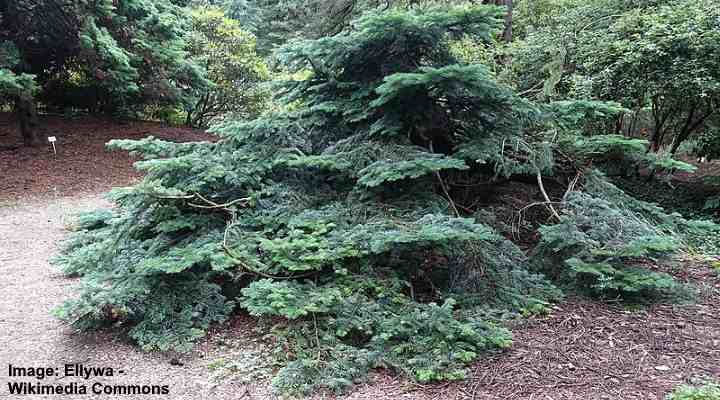
The ‘Spreading Star’ Pacific silver fir is an evergreen shrub with spreading growth habit that can be grown in both sun and shade
This elegant Pacific silver fir is a small evergreen coniferous shrub, identified by its spreading growth habit, horizontal branches, and soft, long green needles. The dense foliage and spreading growth give this low-growing shrub plenty of aesthetic appeal in a small landscape or rockery.
The Pacific Silver ‘Spreading Star’ grows 3 ft. (1 m) tall and 6 ft. (1.8 m) wide.
The Pacific silver fir ‘Spreading Star’ shrub can be planted as understory ground cover, evergreen foliage in a container garden, or a specimen for rock gardens.
USDA growing zones: 6 to 8
Soil: Consistently moist and well-draining soil
Sun exposure: Full sun to complete shade
Small Evergreen Hemlock Shrubs (Tsuga canadensis)

Tsuga canadensis ‘Cole’s Prostrate’ is a shade tolerant evergreen small shrub
Low-growing hemlock shrubs are characterized by their attractive flat sprays of dark green needles, slightly drooping branches, and small pendulous egg-shaped brown cones. Small eastern hemlock shrubs are miniature versions of the enormous specimen trees. The evergreen landscape conifers grow 1.5 – 3 ft. (0.45 – 1 m).
The best Canadian hemlock dwarf cultivars are ‘Nana Gracilis,’ ‘Stockman’s Dwarf,’ and ‘Cole’s Prostrate.’ The small shrubs are ideal for growing in the shade in cooler, northern climates as evergreen ground cover, specimen plants, or foundation planting.
USDA growing zones: 3 to 7
Sun exposure: Partial shade to deep shade
Soil: Humus-rich, moist, well-draining soils
Small Flowering Hydrangea Shrubs
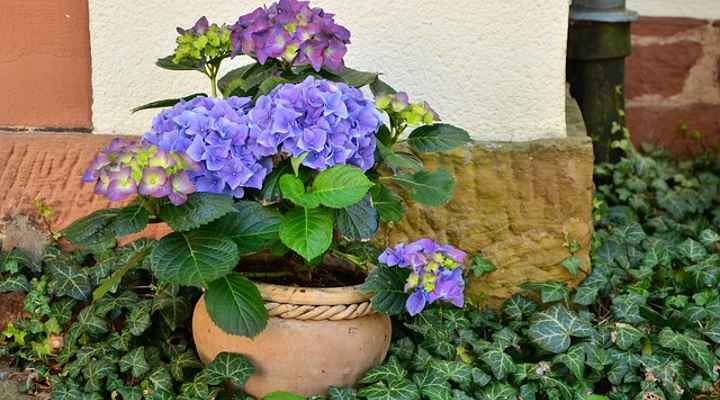
Hydrangea shrubs include many shade-tolerant small cultivars with stunning flowers in a wide array of colors
Small hydrangeas shrubs grow well in shade gardens and dappled sunlight. The mounding shrubs with their massive blooms add aesthetic value to a landscape. Hydrangea flowers can be large colorful globose flower heads in pink, white, and blue colors. Other varieties of hydrangeas have flattened feathery flower clusters.
There are various varieties of hydrangeas, each with varying levels of shade tolerance. For example, shrub hydrangeas perform best in light shade or full sun. Big leaf hydrangeas are suitable for full sun to deep shade. And mountain hydrangeas grow best in partial shade or dappled shade.
Small hydrangea shrubs make for excellent driveway borders, specimen plants, container plantings, and mass planting. Additionally, blue-flowering hydrangeas are among the few shrubs with blue blooms for growing in the shade.
USDA growing zones: 3 to 9 (check individual cultivars)
Soil: Medium, well-drained soil
Sun exposure: Light shade, partial shade, and full shade (more shade required in hotter climates)
Tree Peony (Paeonia suffruticosa)

Tree peony produces beautiful flowers to add pop of color to partial shaded locations
The tree peony is a small, woody deciduous shrub with spectacular showy pink, white, red, and multicolored blooms. The shade-loving mounding shrub is identified by its ruffled, scented spring flowers, lush green leaves, and attractive appearance. Dwarf tree peony shrubs grow between 3 and 6 ft. (1 – 1.8 m) tall.
The pink-blooming ornamental shrub explodes into color in late spring and early summer. Their large prolific blooms can grow up to 10” (25 cm) and make excellent cut flowers.
Due to their medium tolerance of shade, tree peonies are ideal for growing in lightly shaded gardens. However, they need around four hours of sunlight daily. The blooming shrubs are ideal in containers, mixed borders, along a foundation line, or as a specimen plant.
USDA growing zones: 4 to 7
Soil: Consistently moist, well-drained soil that is neutral to alkaline
Sun exposure: Full sun to partial shade
Small Fothergilla (Fothergilla gardenii)
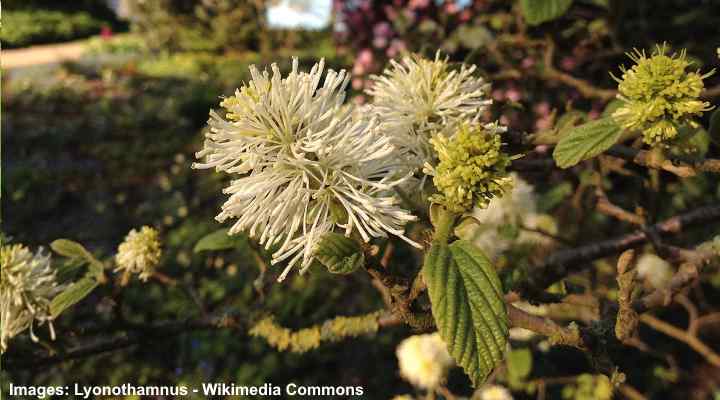
Dwarf fothergilla flowering shrub can grow in full sun or partial shade
Also called coastal witch-alder, dwarf fothergilla is a small shrub with masses of fuzzy white flowers, bluish green leaves, and a rounded, spreading habit. The flowering deciduous decorative bush has unique flowers that look like a toilet brush. The spindly white stamens grow in spikes measuring 2” (5 cm) long.
The white-blooming, small ornamental shrub performs well in dappled sunlight or part shade. The masses of bottlebrush flowers and lush green foliage add color to foundation lines, mixed borders, and shaded garden landscapes.
USDA growing zones: 5 to 8
Soil: Medium to wet soil that drains well
Sun exposure: Full sun, dappled shade, and partial shade
Small Pittosporum Evergreen Shrubs
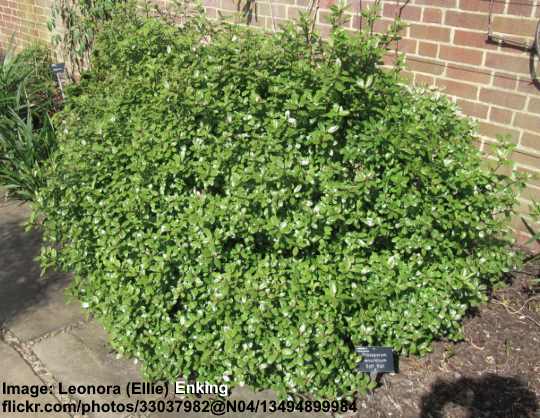
The small evergreen Golf Ball pittosporum (Pittosporum tenuifolium ‘Golf Ball’) can tolerate partial shade
Small pittosporum shrubs are ideal evergreen plants for growing in dappled or partial shade. The ornamental shrubs are identified by their shiny, dark green leaves and small fragrant white flowers. The hardy evergreen shrubs grow about 1 to 3 ft. (0.3 – 1 m) tall and thrive in shade and sunny conditions.
Dwarf pittosporum cultivars have several landscape uses. And some cultivars have creamy-white and green variegated leaves. In addition, the low-growing, shade-tolerant evergreen shrubs are ideal in front yards underneath windows, lining driveways, or growing as a low-growing hedge.
The shrubs also perform well in pots in container gardens, balconies, decks, or covered patio areas.
The small decorative shrubs are also called mock orange due to the sweet-smelling fragrant flowers that emit orangey scents.
USDA growing zones: 5 to 8
Soil: Evenly moist, well-drained soil
Sun exposure: All levels of shade, from full sun to complete shade, depending on the cultivar
Oregon Grape Holly (Mahonia aquifolium)

Oregon grape is a flowering evergreen shrub with yellow flowers in early spring, followed by blue berries
Oregon grape holly is a delightful small shrub, identified by its yellow flowers, waxy blue clusters of berries, and jagged leaves. The flowering evergreen shrub for shade provides year-long ornamental interest. Clusters of golden yellow flowers bloom in spring and contrast with glossy, leathery, dark green foliage. Then in the fall, bunches of edible blue berries appear.
Oregon grape holly is also called holly-leaved barberry. The landscaping shrub grows 3 to 6 ft. (1 – 1.8 m) tall and spreads up to 5 ft. (1.5 m) wide. Plant the yellow-flowering shrub in shade gardens. For example, grow on the north-facing side of a building as a foundation planting. Or grow as a specimen plant or massed in shady borders.
USDA growing zones: 5 to 8
Soil: Organically rich, well-drained soils
Sun exposure: Part shade to full shade
Small Flowering Japanese Skimmia Shrubs (Skimmia Japonica)
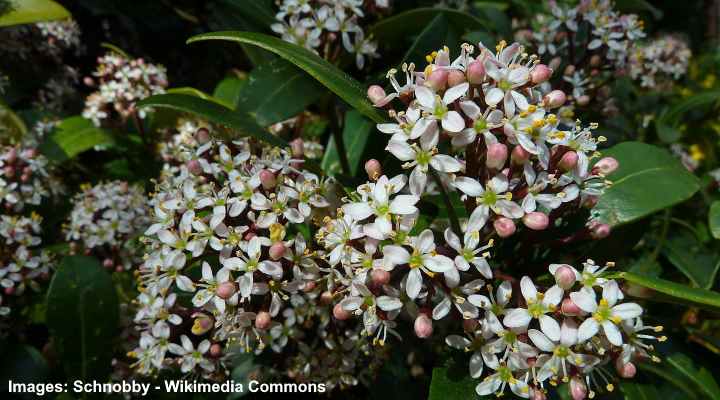
Japanese skimmia is a small flowering evergreen shrub that is easy to care for and loves shade
Japanese skimmia is a white-flowering shrub that thrives in full shade. The easy-grow evergreen bushy plant is identified by its scented pinkish-white flower clusters (racemes), aromatic leathery leaves, bunches of vibrantly colored red berries, and its rounded growth habit. Japanese skimmia shrubs grow 3 to 4 ft. (1 – 1.2 m) tall and 5 ft. (1.5 m) wide.
You can plant the decorative, fragrant shrub in shade gardens as an evergreen hedge, shrub border, and foundation planting. It will also grow well in the constant shadows of tall trees or buildings. You can also grow the shrub in a container for a covered patio or decking area.
USDA growing zones: 6 to 8
Soil: Moderately fertile, humus-rich, moist, well-drained soil
Sun exposure: Partial sun to full shade
Related articles:
